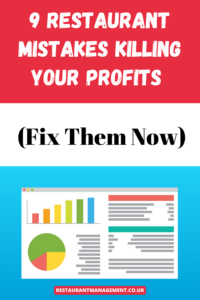Restaurant Mistakes To Avoid
Restaurant mistakes! Have you ever wondered why your favourite local restaurant suddenly closed down? It might have looked busy, but the food was great, and the staff were friendly—so what went wrong? The truth is that running a restaurant is one of the toughest businesses in the world. Even the most passionate chefs and hardworking owners face daily battles that most customers never see. Let’s peel back the curtain and explore the biggest challenges restaurants face—and, more importantly, how they can overcome them.

1. Financial & Cost Management: The Battle with the Bottom Line
Money troubles are the number one reason restaurants close their doors. The costs of running a restaurant are rising fast, and owners are constantly trying to stay ahead. However, with effective financial management, this battle with the bottom line can become a manageable challenge, bringing a sense of control and relief to the owners.
Rising and Fluctuating Food Costs: Ingredient prices can change weekly. One month, tomatoes are affordable; the next, they’ve doubled in price. According to the Office for National Statistics, UK food prices rose 19.2% in the year to March 2023—the fastest increase in over 45 years.
Operational and Rising Costs: Rent, utilities, equipment repairs, and insurance all pile-up. With inflation and energy bills soaring, even successful restaurants can struggle to stay profitable.
Cost Accountancy and Item Pricing: Understanding which dishes make money—and which don’t—is critical. Without proper cost accountancy, restaurants might be losing money on their best-selling items.
Solutions:
Use smart menu engineering to highlight high-margin items.
Buy local and seasonal produce to avoid price fluctuations.
Invest in cost-tracking software to monitor profits daily.
Work with financial advisors who understand restaurant economics.
2. Human Resources & Labour: The People Problem
Restaurants rely on people—chefs, servers, managers—to create great customer experiences. But finding and keeping the right people is more complicated than ever.
Labour Shortages: Since Brexit, the UK hospitality industry has lost thousands of workers. Many EU nationals left, and not enough locals are filling the gap.
High Employee Turnover: According to Ukhospitality, the hospitality industry has one of the highest staff turnover rates in the UK—up to 30% annually.
Hiring and Retaining Talent: Without proper onboarding, training, and growth opportunities, good staff will leave.
Better Communication & Engagement: Poor communication leads to restaurant mistakes, bad service, and unhappy customers. If staff feel unheard or overworked, they stop caring.
Solutions:
Offer clear career paths, not just jobs.
Create a positive, team-focused culture.
Train managers to communicate clearly and respectfully.
Use shift-scheduling apps to improve fairness and reduce burnout.

3. Compliance & Regulations: The Legal Balancing Act
Rules and regulations are strict—and they should be. No one wants to eat in a dirty or unsafe kitchen, but for owners, staying compliant can be overwhelming. However, once these regulations are understood and adhered to, they can provide a sense of security and confidence in the safety and quality of the restaurant’s operations.
Health and Safety Regulations: Restaurants must follow strict health and safety rules about hygiene, food storage, cleaning, and staff safety. Even small restaurant mistakes can lead to fines or closure.
Regulatory Compliance: The paperwork is endless, from allergy information to fire safety checks. In 2014, the UK introduced the Food Information for Consumers Regulation, requiring clear allergen labelling—a rule that still catches many off guard.
Solutions:
Use digital checklists for daily compliance routines.
Train staff regularly and keep certification up to date.
Hire a compliance consultant to audit and improve systems.
4. Customer Experience & Market Trends: Meeting Ever-Changing Tastes
Today’s diners are different. They want more than just good food—they want a complete experience, and they want it now.
Changing Preferences: Vegan, gluten-free, organic—diners are asking more about what’s on their plates. A study by Mintel in 2022 found that 49% of Brits reduced their meat intake in some way.
Evolving Expectations: Guests expect fast, friendly service, Instagram-worthy décor, and technology to make things easier—like contactless payments and digital menus.
Loyalty Challenges: With so many options, customers rarely stick to one place. Restaurants must work harder to keep them coming back.
Solutions:
Use customer feedback tools to listen and improve.
Offer loyalty programs that feel personal and rewarding.
Embrace flexible menus that change with the seasons and trends.
Top 14 Reasons Your Restaurant Is About To Fail Within The First Year
5. Marketing & Branding: Standing Out in a Crowded Market
Being great isn’t enough—people need to know you’re great. That’s where marketing comes in.
Marketing Challenges: Many restaurant owners are chefs or service pros, not marketers. But without strong branding and promotion, even top restaurants go unnoticed.
Online Reputation Management: One bad review can hurt a business. A BrightLocal study found that 87% of consumers engage with online reviews before choosing a restaurant.
Solutions:
Keep your Google listing, website, and social media active and current.
Respond to reviews, whether positive or negative, in a professional manner.
Work with a local influencer or food blogger to get noticed.
6. Menu & Food Quality: Creating Dishes That Delight
A menu is more than a list of dishes—it reflects your brand, cost structure, and kitchen skills.
Menu Optimization: Too many items confuse customers and slow down the kitchen. If there is not enough variety, you lose interest.
Food Quality & Consistency: A burger that’s amazing one day and dry the next is a quick way to lose trust.
Solutions:
Use menu engineering software to balance popularity and profit.
Train chefs to follow standard recipes and plating guidelines.
Use quality control checklists for every shift.

7. Supply Chain & Inventory: Keeping the Kitchen Stocked
Imagine running out of key ingredients on a busy Friday night. That’s what poor inventory management looks like.
Inventory Management: Tracking stock manually leads to waste or shortages. It’s time-consuming and often inaccurate.
Supply Chain Disruptions: Brexit, the pandemic, and climate change have rendered global supply chains more unstable.
Supplier Management: Collaborating with an unsuitable supplier can lead to delivery delays, increased expenses, or inferior quality.
Solutions:
Use digital inventory tools that update in real time.
Build strong relationships with local suppliers.
Keep a backup supplier list for emergencies.
8. Technology & Innovation: Running Smarter, Not Harder
Technology isn’t just for big chains. The right tech can benefit small restaurants hugely. By integrating and adapting technology, many restaurants can move away from slow and error-prone pen-and-paper systems, gaining a sense of control and empowerment over their operations.
Technology Integration & Adaptation: Many restaurants still use pen-and-paper systems, which are slow and prone to errors.
Tech That Works: POS systems, online booking, mobile ordering, and kitchen display screens save time and reduce restaurant mistakes.
Solutions:
Invest in user-friendly technology that fits your operation size.
Train staff properly so they don’t resist new systems.
Regularly update and maintain software to avoid breakdowns.
9. Competition: Winning in a Crowded Industry
The UK has over 100,000 restaurants—from street food stalls to fine dining. To survive, you need more than good food.
Standing Out: Customers remember experiences, not just meals. Your brand, décor, service, and values must all work together.
Solutions:
Find your unique selling point (USP)—what makes you different?
Offer experiential dining—live music, chef’s table, and themed nights.
Focus on hyper-local marketing and community engagement.
Conclusion: Restaurant Mistakes
Running a restaurant is like juggling flaming knives—while riding a bicycle—on a tightrope. But with smart systems, great people, and a clear plan, success is possible.
Restaurants that adapt quickly, listen carefully and invest wisely will not only survive but thrive. Whether you’re a new owner or a seasoned pro, knowing the biggest challenges restaurants face—and how to solve them—is your recipe for long-term success.
If you want to grow your restaurant, start by tackling one challenge at a time. The rewards are worth it. After all, nothing beats the magic of a full dining room and a happy guest.

FAQ’s
What is the biggest problem in the restaurant industry?
The restaurant industry’s primary issue today is a lack of available workers.
The biggest problem in the restaurant industry today is labour shortages.l Many restaurants struggle to find, hire, and keep qualified staff—from chefs and servers to kitchen assistants and managers. Since the COVID-19 pandemic and Brexit, the UK hospitality sector has lost a considerable portion of its workforce. According to the British Hospitality Association, there were over 100,000 vacancies in 2023 alone.
Without enough staff, restaurants can’t provide consistent service, directly affecting customer satisfaction and revenue. Labour shortages also lead to burnout among existing staff, increasing turnover even further.
What is the top challenge for restaurant operators?
The top challenge for restaurant operators is managing rising costs while maintaining profitability. Food prices, energy bills, rent, and wages are all increasing. At the same time, customers are becoming more price-sensitive due to inflation, creating a tightrope for owners who must balance quality, affordability, and profit.
Operators also face pressure to invest in technology, staff training, marketing, and sustainability while monitoring their bottom line. Many are turning to menu engineering, smart inventory systems, and cost control tools to stay ahead.
What do restaurants struggle with the most?
Most restaurants struggle the most with keeping costs under control while delivering high-quality service. Food prices, rent, utility bills, and wages are constantly rising. At the same time, diners expect better experiences, faster service, and more options—often at lower prices.
Balancing this is tough. According to the UK’s Office for National Statistics, hospitality businesses saw one of the sharpest energy and supply costs increases in 2023. Restaurants often work on tight profit margins (as low as 3–5%), so even small financial shocks can cause big problems.
Managing staff shortages, keeping customers loyal, and maintaining consistent food quality are all part of this daily struggle.
What remains the biggest challenge for the restaurant industry?
The biggest ongoing challenge for the restaurant industry is labour recruitment and retention. Many restaurants can’t find enough skilled staff, and the ones they hire often leave within months. The problem has only grown since Brexit and COVID-19.
UKHospitality reported that more than 60% of restaurant establishments are functioning below their full capacity because of a lack of staff. When you can’t find or keep good chefs, waitstaff, or managers, it’s nearly impossible to maintain food quality and customer service—two essentials for long-term success.
Training, culture-building, and better working conditions are now critical to overcoming this challenge.
What is the biggest threat to the restaurant?
The biggest threat to a restaurant is poor financial management, which often leads to closure—even when the food and service are excellent. Many restaurants don’t track their expenses properly, underprice their dishes, or fail to adjust when costs rise.
A report by the Insolvency Service showed that over 2,000 restaurants in the UK closed in 2023 due to financial pressures, not lack of customers.
Not knowing your numbers—like food cost percentage, break-even point, or staff-to-sales ratio—can silently drain profits. Without strong financial controls, a restaurant can look busy and still lose money.
Yet, tackling restaurants’ challenges requires a comprehensive approach covering various aspects., here are some more articles that explore these topics:
Related articles:
Your Restaurant Is About To Fail
How To Manage A Restaurant Business Successfully
Restaurant Management Structure


